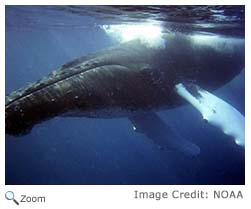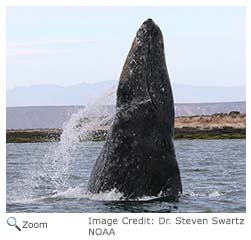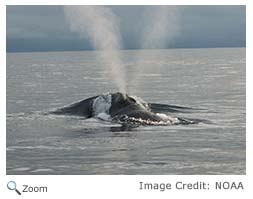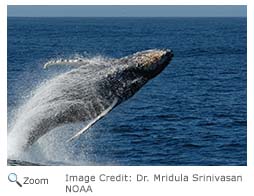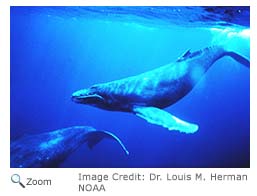Dolphins, Whales and Porpoises |
WhalesWhales are mammals. They bear live young and feed them milk and they have lungs. They breathe air through a blow hole at the top of their heads. Whales often travel in groups or pods. They can be found in all the world's oceans! Open Wide
Thar She Blows!
Belly Flop
Deep Dive
|
Dolphins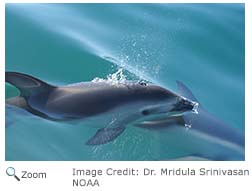 Dolphins are really small, toothed whales! There are 33 species of ocean dolphins, including the bottle-nosed dolphin, the spinner dolphin, the killer whale, the pilot whale and the common dolphin. Most dolphins live in the ocean, but there are five species of river dolphins that live in fresh water. They are all mammals. They bear live young and feed them milk. They have lungs and breathe air. They have fur - well, really whiskers - right after they are born. They lose the whiskers as they grow older. Dolphins have cone-shaped teeth. Most of the dolphin's diet is made up of fish and squid. Dolphins are really small, toothed whales! There are 33 species of ocean dolphins, including the bottle-nosed dolphin, the spinner dolphin, the killer whale, the pilot whale and the common dolphin. Most dolphins live in the ocean, but there are five species of river dolphins that live in fresh water. They are all mammals. They bear live young and feed them milk. They have lungs and breathe air. They have fur - well, really whiskers - right after they are born. They lose the whiskers as they grow older. Dolphins have cone-shaped teeth. Most of the dolphin's diet is made up of fish and squid.
Built for Speed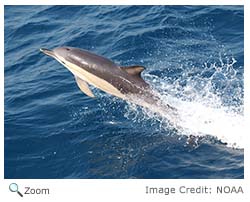 Dolphins are very fast swimmers! They have long, torpedo-shaped bodies; beak-like snouts and smooth skin. They have strong tail fins that they move up and down to help them move through the water. They have a blow hole at the top of their heads that they use to breath through. When dolphins are underwater, they don't hold their breath. The oxygen they need to stay underwater for long periods of time is stored in their blood and muscle. Dolphins are very fast swimmers! They have long, torpedo-shaped bodies; beak-like snouts and smooth skin. They have strong tail fins that they move up and down to help them move through the water. They have a blow hole at the top of their heads that they use to breath through. When dolphins are underwater, they don't hold their breath. The oxygen they need to stay underwater for long periods of time is stored in their blood and muscle.
Just a Few Words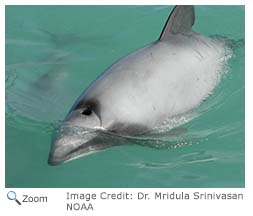 Dolphins are very talkative. They don't have vocal chords, they make clicks and whistle sounds by squeezing air back and forth between air sacs that are just under their blowholes. They use the whistles to "talk" to other dolphins. This helps them identify members of their group and locate each other. The clicking sounds are used for echolocation. Echolocation helps dolphins identify objects, predators and prey. The clicking sounds are magnified and directed by the dolphins melon. The melon is a fatty bulge between the dolphins skull and blow hole. The sounds dolphins make travel out into the ocean. When the sounds hit an object they bounce back to the dolphin. The returning sounds travel through fat deposits in the dolphin's jaw. The sound vibrations then travel to the dolphins inner ear and then the brain! Dolphins can then figure out how far away something is, where it is, how big it is and sometimes even what it is! Dolphins are very talkative. They don't have vocal chords, they make clicks and whistle sounds by squeezing air back and forth between air sacs that are just under their blowholes. They use the whistles to "talk" to other dolphins. This helps them identify members of their group and locate each other. The clicking sounds are used for echolocation. Echolocation helps dolphins identify objects, predators and prey. The clicking sounds are magnified and directed by the dolphins melon. The melon is a fatty bulge between the dolphins skull and blow hole. The sounds dolphins make travel out into the ocean. When the sounds hit an object they bounce back to the dolphin. The returning sounds travel through fat deposits in the dolphin's jaw. The sound vibrations then travel to the dolphins inner ear and then the brain! Dolphins can then figure out how far away something is, where it is, how big it is and sometimes even what it is!
PorpoisesThere are six species of porpoises. Porpoises are often confused with dolphins. Porpoises have blunt noses and don't have a melon. Their teeth are shaped like a spade and they have sharp edges. They are usually chubbier and shorter than dolphins. They are mammals and have a blow hole. |

 There are two groups of whales. The Mysticeti, or baleen whales and the Odontoceti, or toothed whales. The mysticeti have baleen instead of teeth and they have two blow holes.
There are two groups of whales. The Mysticeti, or baleen whales and the Odontoceti, or toothed whales. The mysticeti have baleen instead of teeth and they have two blow holes. 